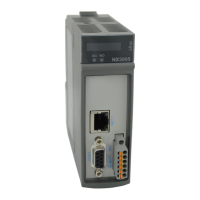5. CONFIGURATION
Figure 48: ExternInterruptTask00 Configuration Screen
5.1.3. SOE Configuration
The SOE (Sequence of Events) is responsible for the generation of a sequence of digital events. Through the SOE it is
possible to analyze the historic behavior of the system variables mapped in its monitoring area. The SOE is an exclusive
service available for the NX3020 and NX3030 models.
Once the SOE service has been enabled, the CPU starts to behave as a DNP3 server, thus it is necessary the support to
the DNP3 protocol by the client for the use of this resource. The supported object types as well as the function codes and the
qualifiers can be found at Annex. DNP3 Interoperability.
The SOE service uses the %Q addresses in order to form its base of static data. For it, it has to be set a continuous area of
%Q memory where the user will inform its beginning and size. For redundant projects the %Q area also has to be redundant
so that in the switchover moment the DNP3 server data base is kept.
The DNP3 first object address will always be 0, corresponding to %QBxxxx’s bit 0, where xxxx is the %Q initial address.
Thus, once defined the static data base, the user must copy each digital point which should generate events within the %Q
continuous area. The maximum number of points which can be copied is 8000.
For the events configuration, it is necessary to inform only the size of the events queue. The SOE uses a special and
dedicated queue (not the one described on Protocols Configuration section), which is persistent and redundant, so the events
will not be lost in the switchover moment neither in case of a power supply failure. In case an overflow occurs in the events
queue, the oldest events will be overwritten. In case in one single cycle are generated more events than what is supported by
the queue, its generation is interrupted and the overflow diagnostic is turned on (SOE[x].bOverflowStatus). For example, if
100+n bits vary in a 100 events configuration, causing a dispose of n events.
The SOE will run in the MainTask context, starting already at the first cycle. The SOE will run at the end of each MainTask
cycle, comparing the mapped bits in order to detect transitions occurred in the cycle. In this way, every cycle in which the events
are generated, an increase of time in this cycle of the MainTask will occur. In the worst case (1000 events, being generated
only 1000 and discarded the remaining ones), this influence will be approximately of 5 ms. Therefore, for an application with
the SOE enabled, the user will have to take into account this time when setting the parameters of watchdog time and interval
of the MainTask.
For the use of it the user must set the following parameters in the SOE Configuration tab:
70

